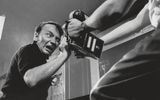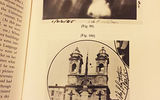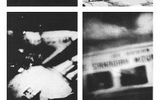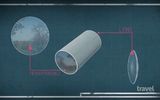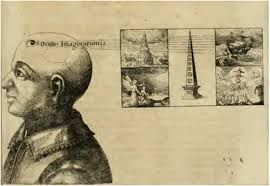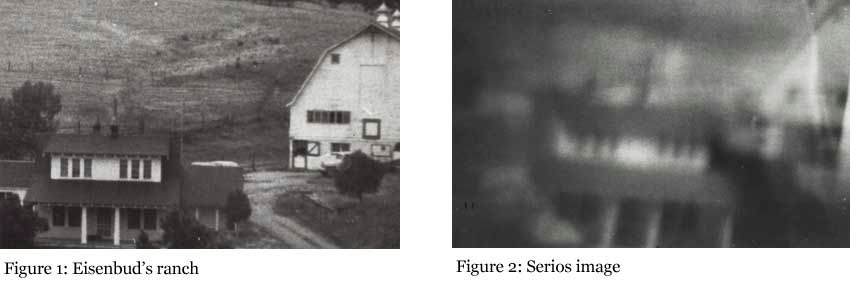
| Added | Fri, 03/04/2020 |
| Источники | |
| Феномены | |
| Версии |
"Malegria" is intended the ability to "burn" the power of thought images on a variety of surfaces such as photographic film. This phenomenon is known also under the names "musicography", "mental photography", "projected thermography", "psychokinetic photo", "mental picture", "engratia", "nanca", "nensha". In the English lexicon, the term "thoughtography" (which literally translates as "malegria") has existed since 1913. "Projected thermography" is a neologism originating from the 2002 "call" of the eponymous remake of a Japanese horror film of 1998.
At the beginning of the 17th century metaphysician, Robert Fludd depicted the inner part of the brain with a certain body, called the "oculus imagingis", radiant table mental paintings are projected onto some sort of screen in the space behind the head. Of course, people immediately became curious to see these images. Almost immediately after the invention of photography enthusiasts began to try to apply this technology for capturing the images that come to mind.
"Malegria" appeared in the late 19th century under the influence of a spirit photograph. One of the first books in which it is mentioned, was published in 1896, Arthur Brunel chatwood of the "New photography" (orig. "The New Photography"). In his book, Chatwood described experiments where the "image of objects on the retina of the human eye, can affect it that you can later get a picture of them looking at a sensitive plate". However, this assertion was immediately criticized in a review published in the journal "Nature".
Investigator-parapsychologist Howard Carrington in his book "Modern psychical phenomena" (orig. "Modern Psychical Phenomena"), published in 1919, wrote that the results of the research, many "mental pictures" were created fraudulently using substitution and manipulation of the photographic plates, double print, double exposure and chemical screens. Some of these photos, he still felt genuine.
One of the most famous people glorified "malegria" in the 1960-ies, has become a Chicago resident Ted Serios. He was a hotel administrator (according to other versions, messenger, Elevator operator, or even unemployed), who argued that since the late forties used psychokinetic powers to create images on film. He began with experiments with hypnosis, which has found that can the power of thought to create an image on the film. First he used a regular box camera, but over time began to use the Polaroid film company. After several years of demonstrations of their abilities to different people and even some researchers in Chicago Serios attracted the attention of a psychiatrist from Denver Jules Eisenbud (1908-1999), who in 1967 wrote a book "the World of Ted Serios: "Militaristische studies of an extraordinary mind" (orig. "The World of Ted Serios: "Thoughtographic" Studies of an Extraordinary Mind"). In the book Eisenbud claimed psychic powers of Serios was genuine.
Creating your photos, Serios usually kept in the hands of a small cylinder or tube from paper (some sources indicate that it was folded from a piece of plastic wrap Polaroid film), which he called "the gizmo". One end of the tube it was sent in the lens of the instant action, the other on his forehead, and pulled the stopper. According to the Serios, it helped him to concentrate mental energies on film. It is interesting that, creating "milligray", often Serios was drunk or at least drank in the process of beer and spirits.
Eisenbud in his book described the process of creating "mental pictures" as follows:
When he was going to take a picture, he seemed to be quickly entered into a state of intense concentration. He stood with open eyes, tight lips and a rather noticeable tension throughout the muscular system. His limbs trembled slightly, as if a light stroke, and the foot of one of his crossed legs sometimes began to twitch convulsively. His face was wet and mottled, forehead were the veins and eyes bloodshot red.
Some sources, by contrast, indicate that the Serios in the process was quite active: a screaming, nervous and behaved almost violently. The observer named Ruth Neal, who in 1966 took part in one of such actions, described it as:
Seven people, including me, gathered in the evening to witness a demonstration of Dr. Eisenbud. Each guest is asked to bring at least five coils of 3000-speed Polaroid film.
Into two chambers, brought Dr. Eisenbud, was made of dozens of pictures. In the process Serios kept in front of the camera lens black paper tube with a diameter of about one inch and a length of inch and a half. He shouted obscenities, distorted face and sometimes shouted "Now!" signal for someone who holds a camera to release the shutter.
Serios was completely drunk and behaved appallingly. Dr. Eisenbud often scolded him, but still continued to serve him beer.
This madness has gone on long enough. The evening came to an end. So far none of the many images not displayed a single thought.
Then, surprisingly, after five long hours, on the next shots there are three strange images (with an interval of one minute, which was required to process each frame). Just using two cameras Serios created six blurry images that are not related to the environment of the room. I was puzzled.
Serios often showed a paper tube that is held in front of the lens so we could see that it was empty. But in a drunken state he finally became careless and slipped when he was flailing his arms and shouting, I saw inside the paper stuff some shiny object.
Serios created images were most often blank or black, but sometimes they could see a fuzzy image, which usually can be interpreted in different ways. On rare occasions a relatively clear and identifiable image, although surrounded by dark spots. In some cases, photos of Serios seemed distorted or changed versions of images of real places or images. On one of the photos seemed to depict ranch Eisenbud. The other part of the building, which was later identified as a hangar belonging to air division Royal canadian mounted police (while the photos the inscription on the plate was made with the error: "CAINADAIN" instead of "CANADIAN"). Dr. Eisenbud tried to prove that previously unidentified photographs were actually images of the surface of Ganymede, but, in his own words, "couldn't get any astronomer or optics scientist to agree."
Meanwhile professional photographers and skeptics found out that Serios faked pictures. In an article published in October 1967 in the magazine "Popular Photography", magicians-Amateurs and professional photographers Charlie Reynolds and David Eisendrath claimed that he caught Serios fraud after spending a weekend with him and Dr. Eisenbud. Interestingly, some sources (for example, at psi-encyclopedia.spr.ac.uk invoking article "The Cruel, Cruel World of Ted Serios") stated that from the information published in the November issue of this magazine, it follows that these photographers have not accepted the invitation of the doctor was not present during the experiments.
In his article, Reynolds and Eisendrath said that he had noticed how Serios slipped something in a paper tube, which, he claims, helped him to concentrate. They suggested that it was a picture, which later appeared in the picture.
In 1968, Professor of physiology and President of the Society for Psychical Research Rushton suggested that photos of Serios was formed using the image printed on the tube in a hidden luminous object. Ruston successfully reproduced the phenomenon of Serios, holding in front of the camera lens is a small reflecting prism with the image from the microfilm.
History of Serios interested in James Randi, a magician and renowned skeptic. Randy claimed to fulfil its photographic trick Serios used a "simple, handheld optical device." Randy wrote that he was able to repeat the focus of the Serios in the TV show in new York, and Eisenbud (which is not admitted, was involved in a Scam fraudulently or deliberately) was "stunned". Again, there are sources (for example, again psi-encyclopedia.spr.ac.uk), stating that Randy was not able or did not even try to repeat the trick of Serios.
According to Professor of neurology Terence Hines:
Serios used what he called a "gizmo," a tube of paper placed against the camera lens. But he also used what no one was talking – a little tube with a length of about one inch and a diameter of inch and a half. At one end of this tube was placed a tiny magnifying lens. On the other end can be inserted a piece of standard 35-mm slides. Placed on the same line as the lens, this device produces an image from the slide film camera. The device was small enough that it could hide on the palm, so he was able to hide even when not at hand was a tube of paper.
Despite the fact that "malegria" the Serios was clearly recognized as a fraud, over the years, it has not been forgotten, and the debate between skeptics and adherents of the method are still underway.
Infiltrated "malegria", in the culture, especially in popular books, movies (mentioned in the beginning of the "call"), TV series (including the hugely popular "x-files"). "Malegria" is used in the art. So, the famous illusionist URI Geller several decades after Ted Serios, in the 21st century, did the same trick, entertaining and surprising its viewers. Still a lot of people are trying to experiment with the projection of thoughts on the film and the matrix digital cameras.
It is worth noting that the University of Maryland, Baltimore County presented a show entitled "Psychic projections/photographic impressions: paranormal photographs from the collection of Jules Eisenbud on Ted Serios" (eng. "Psychic Projections/Photographic Impressions: Paranormal Photographs from the Jule Eisenbud Collection on Ted Serios"). The exhibits are about 60 original frames, many copies of the original images and their enlarged parts, and also one of the Polaroid Land cameras that Serios used in their experiments. Another exhibition you can view short movies that demonstrate the Serios in action. There are records of Eisenbud discussing aspects of the Serios phenomenon, and interviews with professors from the University of Denver, who were witnesses of the experimental sessions of the Serios.
This exhibition periodically calls of outrage from people, as she tells him about the experiments with Serios neutral position, not acknowledging the possibility of the existence of the phenomenon of "milligray", but not denying it. There are people who believe that the organizers are promoting a "milligray" and deny science. Of course, it is not. The subject of the exhibition is not science and the study of the phenomenon, its focus closer to art and philosophy, and the theme of "milligray" is used as a way to force the visitor to reflect on the reality of the surrounding world and to evaluate the authenticity of the pictures of the Serios.
Translated by «Yandex.Translator»
"Thoughtography" appeared at the end of the 19th century under the influence of spiritualistic photography. One of the first books in which it is mentioned was the work of Arthur Brunel Chatwood published in 1896 under the title "New Photography" (orig. "The New Photography"). In his book, Chatwood described experiments in which "images of objects on the retina of the human eye can so affect it that you can later get a photo of them by looking at a sensitive plate." However, this statement was immediately criticized in a review published in the journal "Nature".
One of the most famous people who became famous for "myslegraphy" in the 1960s was a Chicago resident Ted Serios. When creating his photographs, he usually held a small cylinder or a tube made of paper in his hands. He pointed one end of the tube at the lens of the instant–action camera, the other at his forehead, and released the shutter. In 1968, Professor of physiology and president of the Society for Psychical Research Rushton suggested that the photos of Serios were formed using an image applied to a glowing object hidden in a tube, and successfully reproduced the phenomenon by holding a small reflective prism with a microfilm frame in front of the camera lens.
Despite the fact that the "thoughtography" of Serios was unequivocally recognized as a fraud, it found application in art. So, the famous magician Uri Geller, a few decades after Ted Serios, already in the 21st century, did the same trick, entertaining and surprising his audience.
Log in or register to post comments



